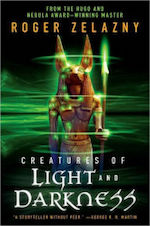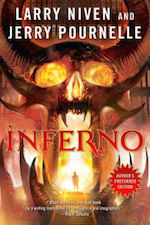I tend to have a weakness for fantasy and science fiction books that take events in myth or history and spin them out oh-so-logically, not as overtly fantastic, but with seeming acceptance of their absolute reality. This probably isn’t surprising since I’ve re-written Loki as a timegod who’s certainly not evil, if still a thief of a very different kind, and also done a logical alternative history series, based on ghosts as real physical phenomena measurable by physics and other purely scientific means… among other things.
So here are five books I didn’t write which provide the same sort of exploration and extrapolation from myth and history, albeit in five very different ways.
The War Hound and The World’s Pain by Michael Moorcock
 The devil’s not just in the details
The devil’s not just in the details
“It was in that year when the fashion in cruelty demanded not only the crucifixion of children, but a similar fate for their pets, that I first met Lucifer and was transported into Hell…” Those are the words by which Captain Ulrich von Bek, the war hound and a mercenary for hire in 1631, begins his tale of a unique bargain with Lucifer, a story which encompasses the Thirty Years’ War and the basic issues foreshadowing the Enlightenment, in addition to being a novel of the Holy Grail, and a love story on both physical and theological levels, told from the viewpoint on an intelligent and pragmatic educated man damned by his time and his acts and forced to deal with a Lucifer who has constructed a Hell that is more like a 1600s version of 1984 or Brave New World than fire and brimstone and screaming souls.
Creatures of Light and Darkness by Roger Zelazny
 The Egyptian pantheon in a high-tech far-future
The Egyptian pantheon in a high-tech far-future
A nameless man wakes in the House of the Dead, where he has served Anubis for a thousand years. He is tortured, questioned, and destroyed—and then re-embodied and sent forth to destroy the Prince Who Was a Thousand, but this nameless assassin is not who or what he seems, nor is the Prince, nor pretty much anyone else in a future Universe where the Tides of Life are pulled by the strings of the House of Life and the House of the Dead. And when the nameless man discovers who he is, then matters get even more interesting.
Inferno by Larry Niven and Jerry Pournelle
 Dante’s Hell updated and re-imagined
Dante’s Hell updated and re-imagined
Allen Carpentier is a popular but not award-winning SF author who accidentally kills himself trying a drunken stunt at a science fiction convention—and no one even notices. Much, much, later, he finds himself in Dante’s Hell, released from captivity in the Vestibule of Hell by a man who seems vaguely familiar and who guides him into the depths of Hell itself, supposedly following Dante’s directions in order to escape Hell and eternal damnation. Along the way, Carpentier sees how modernization has “improved” the torture of the damned, and comes to some interesting conclusions, theological and otherwise, that result in a rather unexpected ending when he finally discovers the identity of his savior.
Tea with the Black Dragon by R.A. MacAvoy
 The most unusually understated black dragon ever
The most unusually understated black dragon ever
This book opens with Martha Macnamara, a fifty year-old professional violinist who, during her visit to her daughter in San Francisco, finds herself having tea with a man of vaguely Oriental appearance and demeanor, but who speaks impeccable English. He knows the background of the classical music she has recorded, and has a wealth of knowledge about everything from computers to the poetry of Yeats, and seems strangely fascinated by her. Yet when Martha Macnamara’s daughter vanishes, he seems to be the only one willing and able to help.
Mozart’s Blood by Louise Marley
 Just how can that soprano know exactly how Mozart wanted the aria sung?
Just how can that soprano know exactly how Mozart wanted the aria sung?
Olivia Voss sings Mozart as if she had composed the arias she performs—as had Teresa Saporiti, Helene Singher, and Vivian Anderson. Olivia remembers all of those performances, and others, especially the one in San Francisco in 1906, the night before the great earthquake. But how is this possible? Opera singer Louise Marley blends a true-to-life depiction of the life of Teresa Saporiti, the soprano who was in fact Mozart’s first Donna Anna, with a dark picture of just how this might have come to happen… and what—and who—lies behind the opera curtains. As a bonus, the technical accuracy of the history and of opera that Marley presents is stunning.
For a runner-up, I’d name Tim Powers’ On Stranger Tides, which offers a fictional and most plausible explanation of the strangeness of the pirate Blackbeard’s demise
All in all, five books with startling twists on history and myth, but twists presented in a different way each time.
Top image: Stargate (1994)
L. E. Modesitt, Jr., is the bestselling author of the fantasy series The Saga of Recluce, Corean Chronicles, the Spellsong Cycle, and the Imager Portfolio. His science fiction includes Adiamante, the Ecolitan novels, the Forever Hero Trilogy, and Archform: Beauty. Besides a writer, Modesitt has been a U.S. Navy pilot, a director of research for a political campaign, legislative assistant and staff director for a U.S. Congressman, Director of Legislation and Congressional Relations for the U.S. Environmental Protection Agency, a consultant on environmental, regulatory, and communications issues, and a college lecturer. He lives in Cedar City, Utah.









